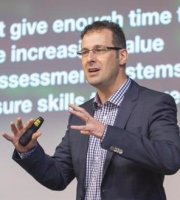The biggest challenge isn’t a technological hurdle. It’s a pedagogical one.
As a science teacher, I would not allow my students to conduct an ‘experiment’ involving chemicals that I hadn’t first trialled myself. In that way I know exactly what is likely to happen. This allows me to give instructions that will minimise hazards and help students avoid errors that might produce disappointing results. Permitting students to mix reagents without a clear knowledge of the product would be stupid, if not negligent.
I think many teachers feel that way with technology, too. Their instinct dictates that before they permit their students to use an app on the iPad, they must first themselves master it’s use, uncover any issues likely to arise and learn how these can be mitigated. Then, and only then, will they allow their students to use it under their step-by-step guidance. While such a cautious approach may be necessary in a science lab, it is not necessary for the effective classroom use of iPads. I would go further and say that such a mindset is not just unnecessary but that it retards student learning.
A teacher’s role in the classroom is to supply direction, maturity and wisdom. It is to raise questions, inspire endeavour and lay down challenges. A teacher brings purpose to the lesson. But to be effective in an iPad classroom, she must relinquish control over the tools used, allowing students to share the responsibility and joy of discovering and sharing solutions to achieve that purpose.
I’m not saying that teachers are absolved of their professional responsibility for learning to use the technology. But they should admit to being learners, and not let that fact stop their students from using the device in unforeseen ways, in the pursuit of the class goals.


You must be logged in to post a comment.